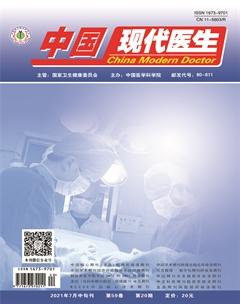經(jīng)導(dǎo)管主動脈瓣置換術(shù)治療重度高危主動脈瓣狹窄患者的術(shù)后護(hù)理
林靜
[關(guān)鍵詞] 經(jīng)導(dǎo)管主動脈瓣置換術(shù);主動脈瓣狹窄;并發(fā)癥;超聲參數(shù)
[中圖分類號] R473.6? ? ? ? ? [文獻(xiàn)標(biāo)識碼] B? ? ? ? ? [文章編號] 1673-9701(2021)20-0162-04
Postoperative nursing of patients with severe and high-risk aortic stenosis treated with transcatheter aortic valve replacement
LIN Jing
Department Ⅰ of Cardiovascular Internal Medicine, Ganzhou People′s Hospital in Jiangxi Province, Ganzhou? ?341000, China
[Abstract] Objective To investigate the postoperative nursing of patients with severe and high-risk aortic stenosis treated with transcatheter aortic valve replacement. Methods A total of 8 patients with severe and high-risk aortic stenosis admitted to our hospital and treated with TAVI from April 2017 to April 2018 were selected as the research objects. After the TAVI operation was completed, the patients were given postoperative nursing, and the nursing efficacies were evaluated. The incidences of adverse events were counted, and the ultrasound parameters of patients at different times before and after operation were compared. Results There were different degrees of adverse events during perioperative period, but there were no other complications such as stroke, death and massive hemorrhage of peripheral blood vessels. Compared with that before operation, Vmax, maxPG, meanPG were decreased significantly, with statistically significant differences(P<0.05), while LVEF was increased significantly, with statistically significant difference(P<0.05). There was no significant change in LVDD compared with that before operation, without statistically significant difference(P>0.05). The patients′ compliance of postoperative nursing intervention was relatively high, and 7 out of 8 patients had better compliance of 87.50%. Conclusion Strengthening nursing care of patients with severe and high-risk aortic stenosis treated with transcatheter aortic valve replacement is helpful to improve the compliance of patients, reduce the incidence of various complications and improve the prognosis efficacy, which is worthy of promotion and application.
[Key words] Transcatheter aortic valve replacement; Aortic valve stenosis; Complication; Ultrasonic parameter
主動脈瓣狹窄發(fā)生的主要因素為風(fēng)濕熱后遺癥或先天性主動脈瓣結(jié)構(gòu)異常,另外,老年性主動脈鈣化也是造成主動脈狹窄的重要因素[1]。其臨床表現(xiàn)為心絞痛、暈厥、呼吸困難、心悸等,具有較高的死亡率。目前,針對重度高危主動脈瓣狹窄(Aortic valve stenosis,AS)的主要治療方式為經(jīng)導(dǎo)管主動脈瓣置換術(shù)(Trans-catheter aortic valve implantation,TAVI),其對患者的創(chuàng)傷較低、術(shù)后并發(fā)癥較少[2]。經(jīng)導(dǎo)管主動脈瓣置換術(shù)是一種新型的介入技術(shù),為高危主動脈瓣狹窄的患者帶來希望,尤其是高齡、置換手術(shù)風(fēng)險較高的患者。另外,對嚴(yán)重高危主動脈瓣狹窄患者進(jìn)行有效的術(shù)后護(hù)理,在一定程度上提高了治療的安全性,保證了治療效果[3]。本研究以進(jìn)行TAVI治療的患者為主要研究對象,探討經(jīng)導(dǎo)管主動脈瓣置換術(shù)治療重度高危主動脈瓣狹窄患者的術(shù)后護(hù)理,現(xiàn)報道如下。
- 中國現(xiàn)代醫(yī)生的其它文章
- 乳腺腺病X線磁共振傳統(tǒng)影像診斷的回顧與新發(fā)現(xiàn)
- AIDET溝通聯(lián)合六西格瑪管理在改善床邊快速血糖疼痛感中的應(yīng)用
- 多學(xué)科合作改善護(hù)士運(yùn)用移動心電工作站的研究
- 后循環(huán)缺血性孤立性眩暈的發(fā)生機(jī)制及其危險因素的研究進(jìn)展
- 細(xì)節(jié)護(hù)理在肝癌切除術(shù)患者圍術(shù)期護(hù)理中的應(yīng)用及對其炎癥反應(yīng)發(fā)生的影響
- 基于認(rèn)知行為療法的院外護(hù)理干預(yù)對單純雄激素剝奪治療的前列腺癌患者影響

